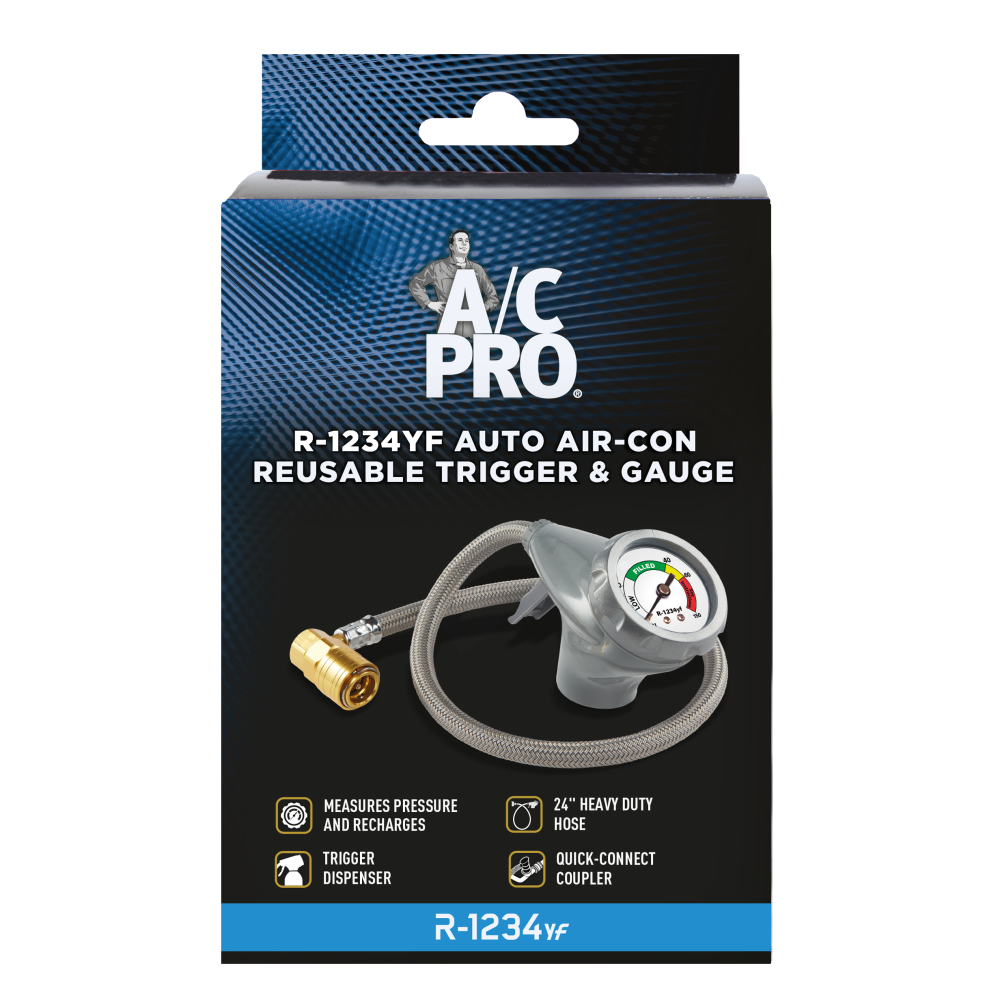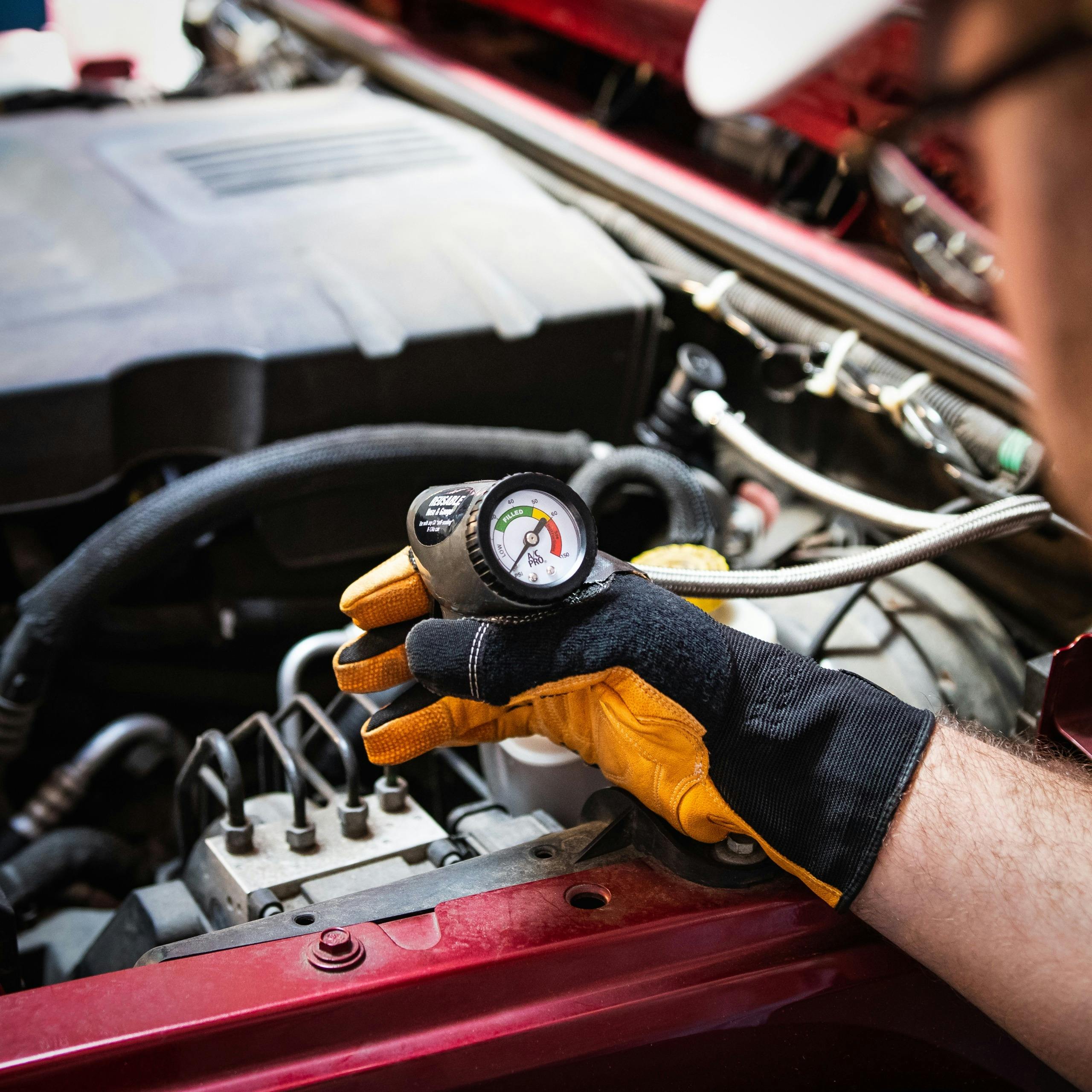AC00093EN R-1234YF Air-Con Reusable Trigger & Gauge

Product features
- Easy to use
- Long hose
- Makes air-con recharge simple
Product Description
A/C Pro®’s R-1234YF auto AC pressure trigger and gauge helps to accurately measure refrigerant pressure and recharge R-1234YF A/C Systems. It can be used independently, without connecting to a gas canister, to check refrigerant pressure and includes an extra-long, heavy-duty hose for easier access to hard-to-reach ports. For R-1234YF A/C Systems only.
- Provides accurate pressure reading and fill
- 24” braided charging hose gives easier access to hard-to-reach ports
- Metal coupler only connects to low side ports in R-1234YF systems
- Can be used independently without connecting to canister
Usage Directions
FOR USE WITH A/C PRO® R-1234YF AUTO AIR-CON RECHARGE (AC00090EN)
- Compatible with STP YF Air-Con Recharge (ST00090EN)
- Find port and leak check – Do not start the engine. Always connect and disconnect with engine off. Locate the A/C low-side service port. You will not be able to connect the high-side port in error. Unscrew the dust cap and connect the coupler of the trigger dispenser. If reading is zero, this indicates there may be an abnormal leak in the system. DO NOT ATTEMPT TO ADD REFRIGERANT. SEEK PROFESSIONAL ADVICE.
- Turn the engine on – set the A/C to maximum cooling. Activate recirculation mode and allow to run for 3 minutes. Ensure the air conditioner’s compressor is running and clutch is engaging.
- Without pressing the trigger, take a pressure reading. Refer to chart below for next step.

- Disconnect the coupler from the low-side port, screw the gauge onto a A/C Por® R-1234YF A/C Recharge canister ANTI-CLOCKWISE and push the coupler onto the vehicle low-side service port. Ensure the engine is off when disconnecting/reconnecting the coupler from the low-side port.
- If the pressure chart suggests that you need to add refrigerant to the A/C system, start the engine, turn the A/C on high and activate recirculation mode. Shake the can and squeeze the trigger while rotating the can from the 12 to 3 o’clock position.
- Check the pressure every 10–15 seconds by releasing the trigger. Charging is complete when the needle is in the green zone. BE CAREFUL NOT TO OVERCHARGE YOUR SYSTEM. Do not let the needle past the green zone.
IMPORTANT: ALWAYS WEAR GLOVES AND SAFETY GOGGLES WHEN RECHARGING YOUR SYSTEM.
Keep out of reach of children.
FAQs
-
Not only is overcharging your system potentially dangerous, an overcharged system will not function properly and can seriously damage your A/C compressor or other component parts. The symptoms of an overcharged A/C system are exactly the same as a system that is undercharged: warm air out of the vents.
In order to prevent overcharging your A/C system it is imperative to measure the pressure before beginning to charge it. To measure the pressure in the A/C system, attach a pressure gauge to the low side port. Your car must be running with the A/C system set to maximum cool and the fan in its highest setting. It is important to note that the proper pressure in your A/C system is dependent on the ambient (outside) temperature. To determine the proper pressure for your system consult a pressure chart such as this one, or set the bezel arrow on your pressure gauge to the corresponding ambient temperature and charge to the pressure corresponding to that temperature setting. If the outside temperature is at or below 55°F do not charge your car. Also, never charge your vehicle above 55 Psi.
-
No. Your car’s A/C refrigerant never goes bad. Nor do you “use up” the refrigerant that is in your system. If your vehicle’s A/C system pressure is low, your vehicle has a refrigerant leak and that leak will need to be repaired in order for your system to hold refrigerant. If your vehicle is able to maintain a charge for a period of two weeks or longer, then it is possible to seal the leak with sealant such as Super Seal. If your system will not hold a charge for at least a two week period then it is advisable to seek professional assistance to find and repair the leak.
-
The most common reasons for the pressure gauge to indicate a red/high pressure reading are the car is not running, or the A/C is not on with the fan switch set to high and the temperature at its coldest setting. In order to obtain an accurate pressure reading the car must be running, the A/C set to the coldest position, and the fan setting set to high. Also, as the car’s compressor cycles on and off, the needle on the gauge will move in and out of the red/high pressure area of the gauge. This is normal. Here is an example of a car compressor cycling on and off:



